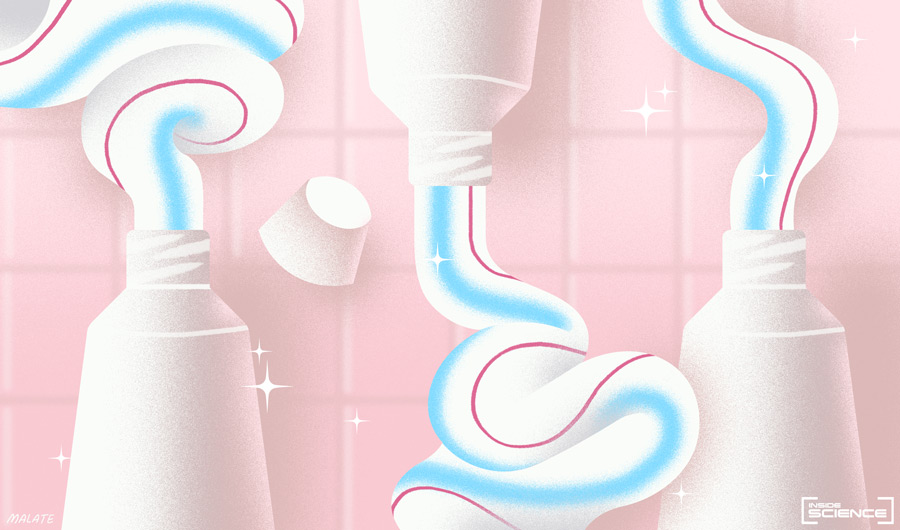How the Toothpaste Got its Stripes

Abigail Malate, Staff Illustrator; Homepage Image: Dusan Zidar/Shutterstock
Copyright American Institute of Physics
(Inside Science) -- Remember as a kid sitting slack-jawed at a friend’s birthday party, all as the county’s cheapest magician sawed a lady in half? That’s kind of what it feels like to watch Ryan Battistella squeeze tube after tube of toothpaste into the toilet on his TikTok account. In a series of three viral videos posted in late November, Batistella and a friend used a variety of techniques -- and profanities -- as they mixed up the contents of nearly half a dozen tubes of striped toothpaste, only to discover that when they squeezed the tubes, stripes still came out.
With each trial, they dug deeper and deeper into the mystery. What began as kneading an unopened tube before using it devolved into a frenzied Batistella cutting open a tube from the bottom to mix the contents with a knife, showing the homogenous grey contents to the camera before squeezing out -- you guessed it -- black-and-white striped toothpaste from the nozzle. There’s a humor to watching two grown men become completely unraveled over tubes of Colgate Optic White (by the end of the third video, one of them was simply shrieking "It’s a portal!" over and over), but their confusion didn’t appear to be a bit. The creators were just as mystified as their audience.
More stories about fun physics from Inside Science
From LEGOs to Ziploc: The Science of the Snap Fit
The Earth's Equatorial Bulge Shapes the Planet's Physics
Why Is Ice Slippery? It's Not a Simple Question
Where you see what looks unexplainably magical in the everyday, there’s usually science at play. The comments sections of Battistella’s videos were flooded with theories citing the physical properties of toothpaste and the inventive engineering of toothpaste tubes. In a very loose approximation of the scientific method, Battistella took it upon himself to tackle some of the easier-to-test hypotheses posed.
Hypothesis: The tube is divided with barriers preventing the mixing of stripes. This was disproven when cutting open the tube revealed only one interior chamber.
Hypothesis: The stripe effect is added by a deposit of color stored right up against the tube’s nozzle, with special holes on the side of an interior tunnel designed to pull paste from the top -- as shown in this YouTube video of a tube of the company’s Dentagard toothpaste. This was disproven when Battistella rinsed out one of the Colgate tubes completely and found no such mechanism.
To crack the case, Inside Science turned to Sergio Leite, vice president of global oral care research and development at Colgate.
The answer, as it so often is, is the simplest one: Battistella really had mixed a portion of the tube’s contents together into one grey mass, and the tube had no engineering secrets that could restore the stripes. But he hadn’t stirred deep enough, and some of the toothpaste had been left striped. Even though it looked like he’d squeezed for long enough to empty the whole tube, he hadn’t—the grey had remained inside, inching closer and closer to the opening but cut off before its grand entrance.
It’s here that the real illusion appears, says Leite. How can the tube still be so full, when we’ve watched what feels like an eternity of toothpaste pump out of it? The secret is in the thickness and viscosity of toothpaste. It’s the same property that guarantees when you squeeze a bit onto your toothbrush, it doesn’t continue running off the end. "Toothpaste is not as easy to mix as you’d think," said Leite. When you mash a full tube of toothpaste, "it may look like you’re mixing, but you’re not really mixing."
To demonstrate what happens on the inside of a striped tube, Leite held up an empty zip-close bag on Zoom, then filled it with a few squirts each of ketchup and mayonnaise. When nestled side by side, the deposits of each condiment remained fairly separate no matter how much he squished the bag about -- thanks to the viscosities of the substances, they were unable to fully mix with one another. All that happened was a slight blurring of the border between the two. In the video, said Leite, "what the kids are doing is kind of doing something like this. It doesn’t really mix."
What about the video where Battistella mixes the paste with a knife? He really is combining some of the stripes, said Leite, but it’s a much smaller portion than it looks like. "If you mix kind of in the middle [of the tube], you don't really get really the borders," Leite said. "When the kids were squeezing, and you see the stripe, you're seeing really the outer edges."
The viscosity of toothpaste, it turns out, causes the product on the edges of the tube to be pushed down and out first, rather than what’s in the middle. Had Battistella continued squeezing, the paste would have eventually come out grey and mixed, said Leite, but the viscosity created the illusion that he’d emptied a larger portion of the tube than he actually had.
There’s a lot of science that goes into the creation of a tube of striped toothpaste, Leite explained. When his team is developing a new product, they have to ensure that the toothpaste in every stripe has the same physical properties, which prevents one from squeezing out faster than the other. They use a science known as rheology, and it’s the reason stripes even stay intact in the first place. Colgate doesn’t use any fancy technology in the cap or subdivided tubes to pack their striped toothpastes -- they simply load them in the top -- in slices of sorts that look, from a bird’s-eye view, like slices of pizza, explained Leite -- and the stripes are preserved thanks to even resistance to mixing.
But the boundaries of toothpaste science are far from rigid. Customers seem to prefer the stripes to regular uniform toothpastes -- could other patterns become a reality in our tubes? "My dream would be to do a plaid, with the stripes going in both directions," said Leite. Good luck mixing that.

